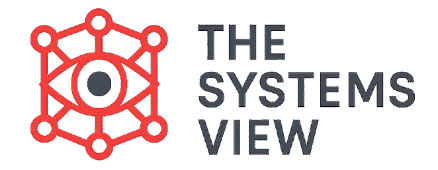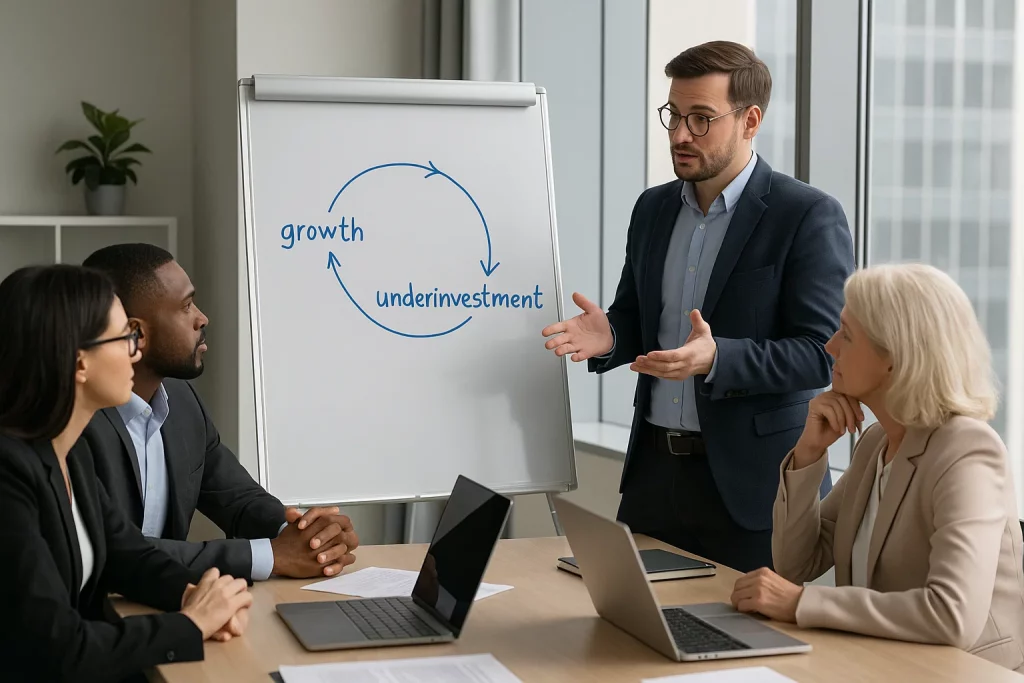We have explored several systems archetypes that describe a slow decline. Now, let’s look at a pattern called Growth and Underinvestment. This archetype happens when a group is successful and growing, but it doesn’t invest enough in the infrastructure it needs to handle that growth. The quality of the product or service suffers, and soon the growth stops.
Imagine a new bakery that makes the best bread in town. It gets more and more customers, and business is booming. But the owner doesn’t buy a new, bigger oven or hire more bakers. Soon, the bakers are overworked, the bread quality drops, and customers start going to other bakeries. The bakery’s success created a need for investment, and the lack of that investment is what ultimately stopped its growth.
What is the Growth and Underinvestment Archetype?
This archetype is a pattern where a reinforcing loop of growth is balanced by a lack of investment. The key parts of this pattern are:
- The Reinforcing Loop: This is the part that drives the growth. It could be great marketing, high quality, or good service. (e.g., A product’s high quality leads to more customers, which gives you more money to invest in the product).
- Performance Standard: This is the level of quality or service the group wants to maintain. (e.g., The bakery wants to always have fresh, high-quality bread).
- The Balancing Loop (Underinvestment): This is the part that stops the growth. If the performance standard is not met due to a lack of investment, it creates a balancing loop that slows down the reinforcing loop. (e.g., The bakery is too busy to make high-quality bread, so customers stop coming).
The trap is that the group often lowers its performance standards to deal with the pressure of growth, instead of investing to maintain them. This lowering of standards is a form of “Drifting Goals,” and it is what ultimately kills the growth.
Important: The key lesson of “Growth and Underinvestment” is that growth will create a need for more investment. If you don’t meet that need, you will not be able to maintain your performance, and the growth will stop. You cannot grow forever on the same foundation.
A Common Example: A Startup Company
This archetype is often seen with fast-growing startup companies.
- Reinforcing Loop: A new software company releases a popular app. The company gets more users and more money. The money allows them to hire more people to make the app even better, which gets them even more users.
- Performance Standard: The company wants to have an app that works quickly and without bugs.
- Balancing Loop: The company gets so many new users that the app’s servers can’t handle the traffic. The app slows down and crashes. Instead of investing in better servers, the company decides to just “deal with it” for now. The poor performance makes new users leave, and the growth stops. The lack of investment led to the failure of the company’s growth.
The Practice Example from the Ebook: Airlines and Service Quality
The ebook gives an example of airlines. For years, airlines struggled with a “Growth and Underinvestment” pattern.
- Reinforcing Loop: Airlines tried to grow by getting more customers and expanding routes. This gave them more money, which they could use for more planes and routes.
- Performance Standard: The standard was to have happy customers who would fly again.
- Balancing Loop: The airlines didn’t invest enough in things like flight maintenance, baggage handling, and customer service. As they grew, the quality of their service went down. Customers became angry, delays became common, and the airline’s reputation was damaged. The growth eventually stopped because they couldn’t deliver on their service standards. The real solution was to invest in all the things that support growth, not just the growth itself.
How to Find a Lasting Solution
To break this cycle, you must be willing to invest to support your growth.
- Be Honest About the Gap: Be honest about the difference between your performance standard and your actual performance. Don’t lower the standard to avoid the problem.
- Invest in Your Foundation: Look for the parts of your system that are being stretched by growth (e.g., your staff, your technology, your processes). Invest in these areas to make them stronger.
- Adjust Growth to Investment: Sometimes, you might need to slow down growth to give yourself time to invest in the foundation. It’s better to grow slowly and have a strong foundation than to grow too fast and crash.
- Hold to the Standard: The most important step is to hold to your performance standard. Don’t let it drift. The gap between your performance and your standard is what signals that you need to invest.
Conclusion
The Growth and Underinvestment archetype teaches us that growth is not free. It comes with a need for investment in the systems that support it. By learning to recognize this pattern, we can stop trying to grow without a solid foundation. Instead, we can make smart investments to maintain our performance standards, ensuring that our success is not just a short-term story, but a long and sustainable journey.



